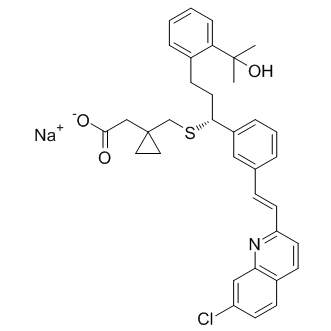| Cas No.: | 151767-02-1 |
| Chemical Name: | sodium (R,E)-2-(1-(((1-(3-(2-(7-chloroquinolin-2-yl)vinyl)phenyl)-3-(2-(2-hydroxypropan-2-yl)phenyl)propyl)thio)methyl)cyclopropyl)acetate |
| Synonyms: | MK-476; MK476; MK 476; Montelukast sodium; trade names Singulair; Montelo-10; Monteflo; Lukotas; Lumona. |
| SMILES: | [Na+].C(CS[C@H](C1=CC=CC(/C=C/C2C=CC3C(N=2)=CC(Cl)=CC=3)=C1)CCC1=CC=CC=C1C(O)(C)C)(CC([O-])=O)1CC1 |
| Formula: | C35H35ClNNaO3S |
| M.Wt: | 608.16877 |
| Sotrage: | 2 years -20°C Powder, 2 weeks 4°C in DMSO, 6 months -80°C in DMSO |
| Description: | Montelukast sodium is a potent, selective CysLT1 receptor antagonist. |
| In Vivo: | Montelukast significantly reduces mild, moderate, and part of severe exacerbations in chronic mild to moderate asthma, but it has inferior efficacy to ICS or ICS plus LABA[2]. Rats with induced asthma have up-regulated NK1R expression in the airway, and montelukast can down regulate NK1R expression during airway remodeling[3]. Blockade of CysLT1R by repeated treatment with montelukast (1 or 2 mg/kg, ig, 4 weeks) reduces Aβ1-42-induced CysLT1R expression and also suppresses Aβ1-42-induced increments of NF-κB p65, TNF-α, IL-1β and caspase-3 activation, and Bcl-2 downregulation in the hippocampus and cortex. Correspondingly, montelukast treatment significantly improves Aβ1-42-induced memory impairment in mice, but has little effect on normal mice[4]. |
| In Vitro: | Montelukast may contribute to the reduction of eosinophilic inflammation in upper-airway inflammatory diseases such as rhinitis and nasal polyposis. Montelukast has a significant inhibitory effect on FBS-induced GM-CSF, IL-6, and IL-8 secretion, but not sICAM-1, in nasal mucosa and polyp epithelial cells. Montelukast also shows an inhibitory effect (p<0.05) on ECM-induced eosinophil survival from both nasal mucosa and polyp epithelial cells[1]. |






















